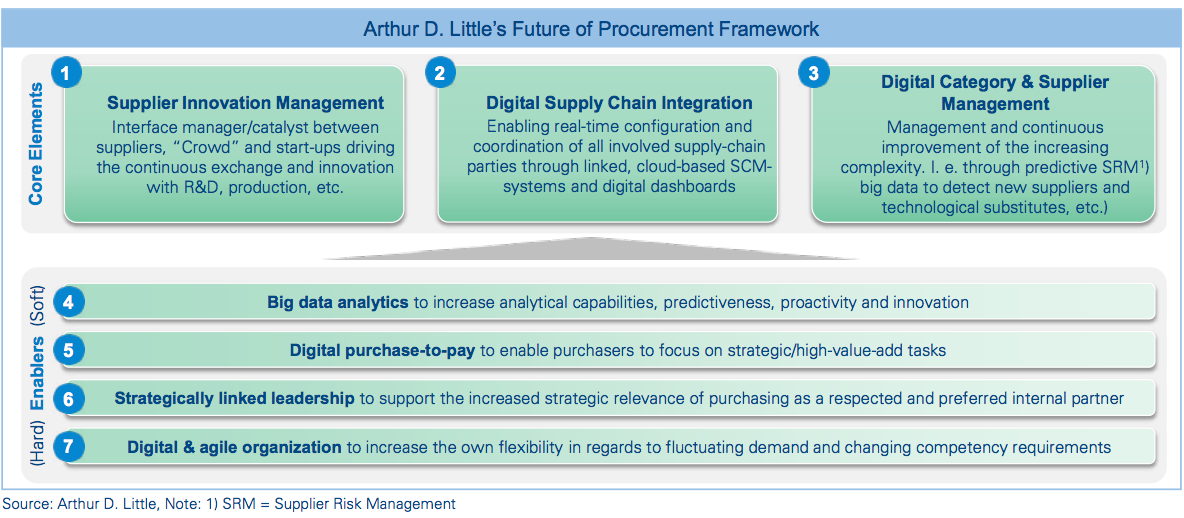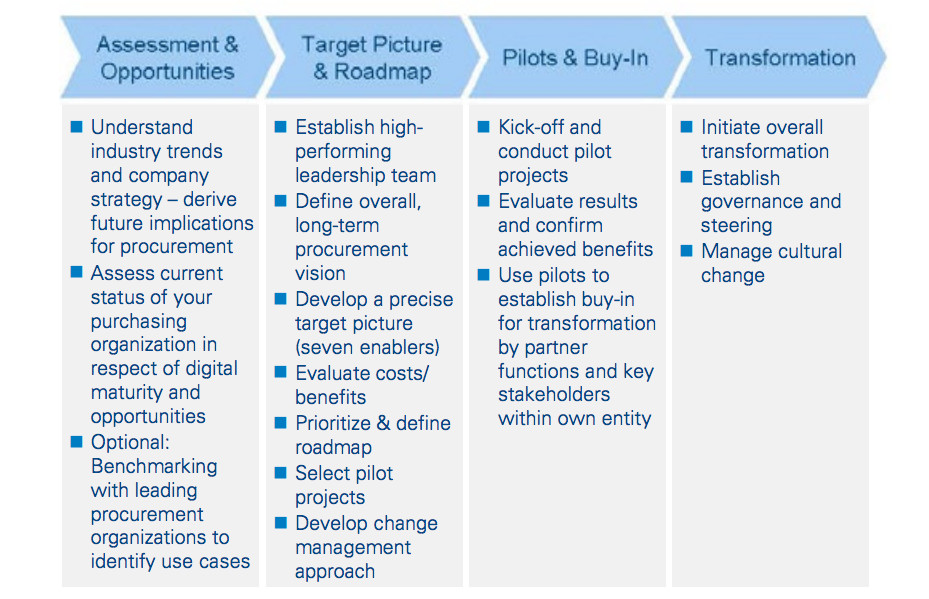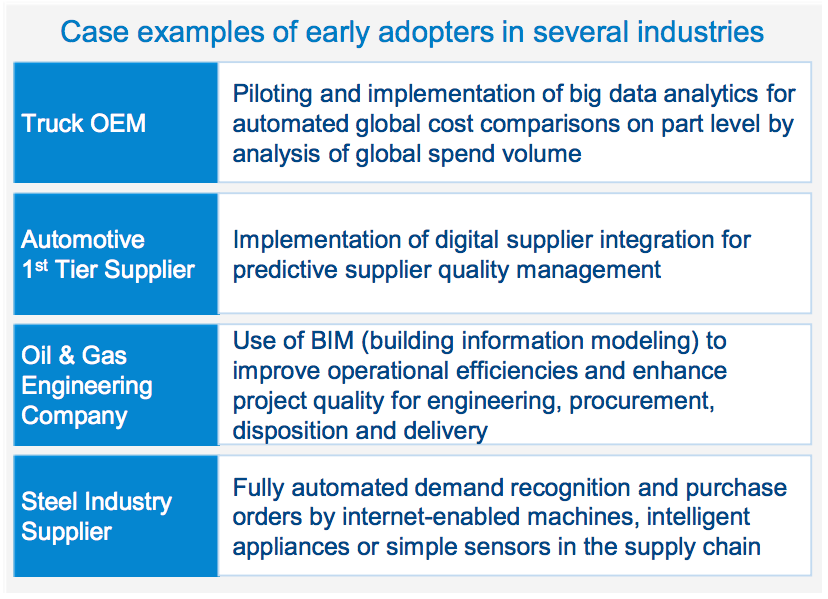
In the digital world procurement will increase its corporate value as an innovation "catalyst" by linking essential external knowledge and competencies with internal business partners to ensure technology and market leadership of the own enterprise, despite decreasing in-house value-add and related know-how. To help procurement functions, Arthur D. Little has developed a Future of Procurement (FP 4.0) Framework consisting of seven components, which will enable procurement to generate value, drive supplier-enabled innovation and manage more and more complex supply chains in real time. Leaders in procurement in several industries are already transforming their businesses by integrating these components into their internal and external supply chains.
Innovative, Agile & Linked Procurement – Vision 2020

The world is changing: decreasing levels of in-house value-add and increasing speed of market and technological changes require procurement to transform into an agile, linked innovation leader and real-time, integrated supply-chain manager. In the digital world procurement will increase its corporate value as an innovation “catalyst” by linking essential external knowledge and competencies with internal business partners to ensure technology and market leadership of the own enterprise, despite decreasing in-house value-add and related know-how. To help procurement functions, Arthur D. Little has developed a Future of Procurement (FP 4.0) Framework consisting of seven components, which will enable procurement to generate value, drive supplier-enabled innovation and manage more and more complex supply chains in real time. Leaders in procurement in several industries are already transforming their businesses by integrating these components into their internal and external supply chains.
The situation: Hyper-competition and value chains restructuring
Yesterday’s markets were best described with 60–80% inhouse value-add, local/stable markets and slow technological changes. Today’s and future markets, however, are characterized by decreasing in-house value-add (reaching levels of 10% or less), global and unstable markets (hyper-competition) and rapid technological development.
The challenge: Generate procurement value in complex and volatile supply chains
In past times procurement’s priority was to ensure delivery of services and goods on time, in full (OTIF) to operations at best life-cycle cost (LCC). In future this will not be enough to ensure market leadership of the own enterprise. Due to decreasing in-house value-add the supply chain is becoming more and more complex, and critical know-how is more often found at a supplier than in-house. Procurement will need to shift its priority to increasing enterprise value by enabling innovation with suppliers, the “crowd” and start-ups. At the same time, procurement will still need to ensure OTIF deliveries by real-time management of more complex supply chains at best life-cycle value.
Life-cycle value – in comparison to LCC – implies a shift from making sourcing decisions based on the life-cycle cost to making them based on the cost and additional enterprise value generated through purchased goods and services and new supplier relationships. For example, in the procurement of a seat for a passenger vehicle, the additional sales volume generated by offering a comfortable seat rather than a low-cost seat should also be considered. Besides increasing the enterprise value of procurement, more and more procurement leaders are confronted with cost-down objectives at the same time. Achieving these new objectives requires a strong shift from administrative procurement tasks to strategic, value-generating procurement activities.
The solution: Transform procurement into an agile, linked innovation leader and catalyst
Arthur D. Little has developed with procurement leaders an enabling framework for the future of procurement. It is structured in three core and four enabling elements, and will enable procurement to drive supplier innovation, in order to digitally manage a more and more complex supply chain and accelerate performance of strategic supplier and category management based on new digital technologies and approaches. The Arthur D. Little framework is intended to guide and support chief procurement officers in developing their company-specific digital procurement visions, roadmaps and transformation plans. The first core element is supplier innovation management. It is extending the innovation capabilities of the own enterprise by systematically integrating knowledge and competencies of key suppliers, start-ups and the external “crowd.” Procurement should fulfill its role as an interface manager and catalyst between these external partners and internal functions, such as R&D, product development and production. This requires activities from procurement, such as:
- Linking the R&D strategy with the procurement strategy and the project portfolio, supported through digital dashboards/ KPIs, jour fixes, etc.
- Supplier market innovation scouting based on big data and advanced analytics to detect new technologies, product substitutes, new suppliers and start-ups.
- Linking internal departments with suppliers, the “crowd” and start-ups through open innovation and innovation contests, pre-RFQ specification-prototyping workshops with suppliers, etc.
- Crowd-sourcing.
- Establishing labs, which are potentially shared with key suppliers, with the intent to push innovation through design thinking, rapid prototyping, minimal viable products, etc.
The second core element is digital supply-chain integration. It enables real-time configuration and coordination of all involved supply-chain parties through linked, cloud-based SCM-systems and digital dashboards to achieve 100% OTIF and reduce inventory. Procurement, in this case, is the Integrated Supply Chain Manager responsible for configuring and coordinating the overall supply chain, including tiers and customers. For this, the following capabilities are required:
- Supply-chain design, modeling and simulation based on big data under consideration of new concepts and technologies such as on-demand printing and packaging (ODP), late-stage packaging, drones, 3D printing and RFID on all levels (first: palette; second: boxes; third: end product).
- Predictive supply-chain management based on predictive analytics, enabled by early information about potential supply-chain risks and interruptions such as storms, capacity restraints and insolvencies.
- Real-time shipping tracking and online best-price freight booking, as well as sharing with third-party providers, i.e. Uship.com, http://fr8.guru/
- Cloud-based digital dashboard linking of all supply-chain parties and continuous steering in joint jour fixes.
The third core element, digital category & supplier management, is enabling strategic management and continuous improvement of the increasing level of out-of-house value-add and technological complexity. Procurement will remain in charge of supplier and commodity management – however, enabled with improved “digital” capabilities:
- Predictive supplier risk management (SRM) to detect supplier failures early on.
- Digital supplier scorecards, objectives and improvement tracking.
- Automated tracking of target achievement and bonus/malus payments.
The future of procurement is characterized by seven digital enablers, which will help purchasing to drive innovation within its own enterprise and manage a real-time linked supply chain

- Digital claim management system with integrated automatic warning systems.
- Big data analytics to detect new suppliers globally and reduce monopolistic or oligopolistic markets.
- Big data analytics and automated commodity-strategy development and implementation, including automated market analysis, portfolio-matrix evaluation, automated strategy design, etc.
- Digital/automatic DUNS (Data Universal Numbering System) and UNSCP (United Nations Standard Products and Services Code) systems and cleansing – synchronized and linked with existing R&D classification system.
The following four elements within Arthur D. Little’s FP4.0 Framework enable the above digital core elements; two address “hard facts” and two are of human-centric, “soft” nature:
- Big data analytics aims at increasing analytical capabilities, predictiveness, proactiveness and innovation. Procurement takes over the role of a big data manager and establishes big data tools and competencies to enable the above-mentioned related capabilities, i.e. supplier market innovation scouting, predictive SRM, identification of new suppliers globally, improving commodity strategies and preparation of negotiations.
- Digital purchase-to-pay process enables procurement to focus on strategic and high-value-add tasks by reducing repetitive tasks. In the future, procurement will spend minimal necessary time on controlling the automated processes, which include, for example:
- Automated master-data cleansing with digital DUNS and UNSPSC systems.
- Automated checking of OTIF fulfillment & reminders to suppliers.
- Automated approval and release of bills and selection of themost profitable payment terms.
- Automated bonus/malus payments based on achievements of targets or volume discounts.
- Digital claim management systems with automated warnings.
- Strategically linked leadership is necessary to support the increased strategic relevance of procurement and position the procurement manager as a respected and preferred internal business partner. In the future procurement will take over the role of a leader within its own enterprise. This requires, however, strengthening of own innovation and leadership competencies by hiring high-potentials, technologists and training purchasers in functional, management and leadership competencies.
- Digital & agile organization, culture, management systems and e-learning increase flexibility with regards to fluctuating demands and changing capability requirements. To meet these continuously changing demands, procurement will need to transform into an agile business partner characterized by:
- Digital & Agile organizational structure: two-fold organization (i.e. one organization managing the legacy business – in addition to one networked/shadow organization for digital transformation initiatives; P. Kotter “Accelerate”, HBM, December 2012); flat organization with no or reduced hierarchy, and “accountability” and “responsibility” assigned to one employee .
- Digital & agile methods and approaches: speedboats, innovation labs, venture-capital funds (to establish or support start-ups and own employees with great business ideas, agile project management (design thinking, SCRUM), flexible working environment (mobile work stations, work from home, virtual 3D conferencing, etc.).
- Digital & agile culture: customer-obsessed, fail-fast/trust culture with a focus on results (dashboards, objectives) and being an innovation leader.
- Digital & agile employees: digitally enabled (connected, online, real time), multi-skilled purchasers (through job rotation & enrichment) who continuously develop their functional, intercultural, leadership and/or management capabilities through flexible e-learning systems and apps (“Babbel”, etc.), and spend 20% of their time on “free” innovation (a là Google).
Conclusion and the way ahead for Procurement 4.0 transformation
Transformation into an agile, linked innovation leader follows the seven elements described above and requires years, since – in addition to digitalization of processes – a culture change and empowerment of procurement is required.
Arthur D. Little proposes a four-step approach for a future of procurement/Procurement 4.0 transformation:

Results of a successful FP4.0 transformation:
Successful transformation into innovative, agile and linked procurement delivers these subsequent results:
- Substantial increase in enterprise value ranging from 5–10% of EBIT through an increased innovation level with suppliers, crowd and start-ups, and focus on best life-cycle value
- One hundred percent on-time & in-full delivery
- Procurement established as innovation leader and preferred business partner
- High satisfaction and retention of procurement employees due to strategic job profiles
- Automated/digital processes free up time (and, if required, resources)
Early adopters in several industries are already transforming their businesses by integrating these elements into their internal and external supply chains





